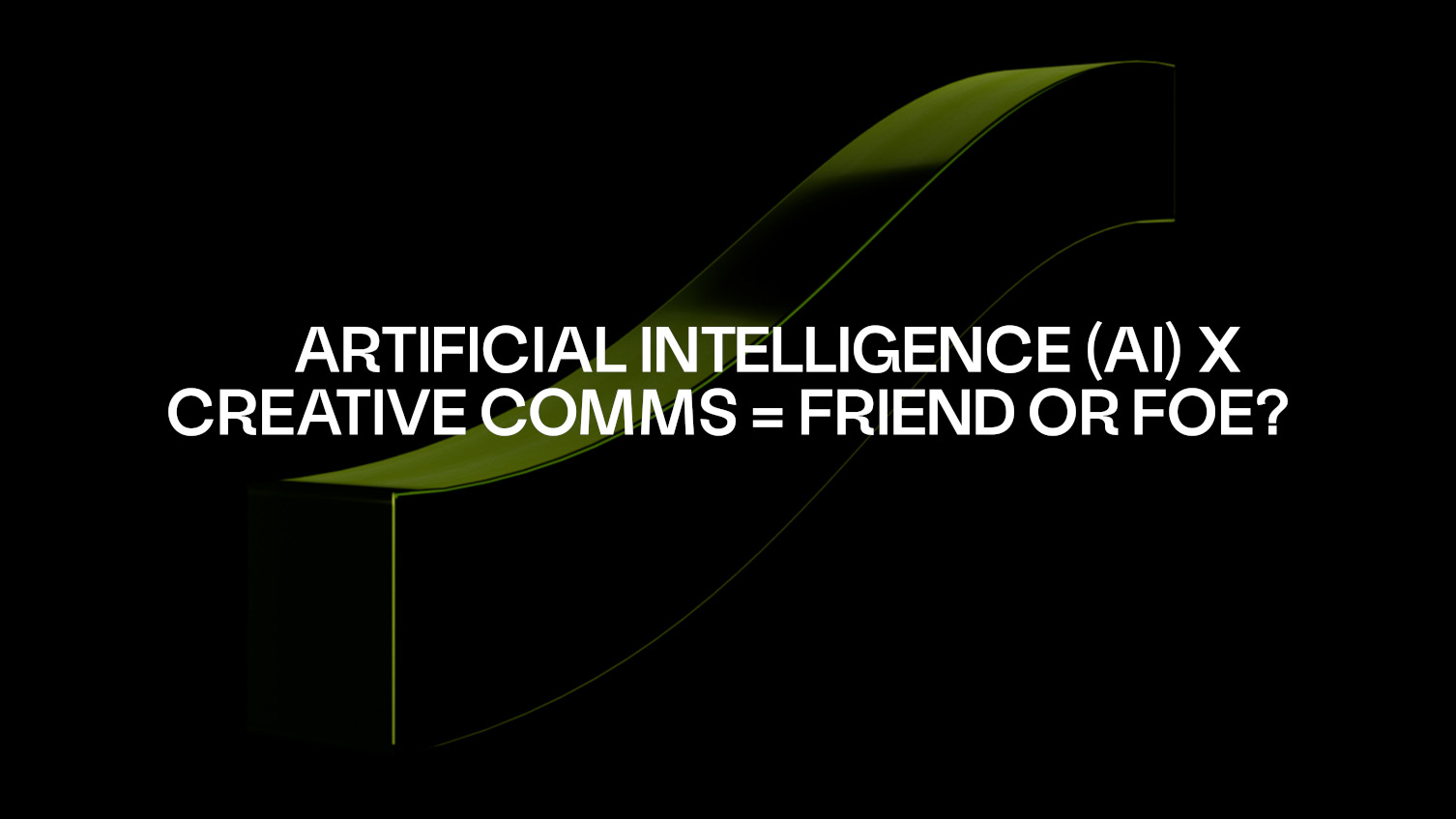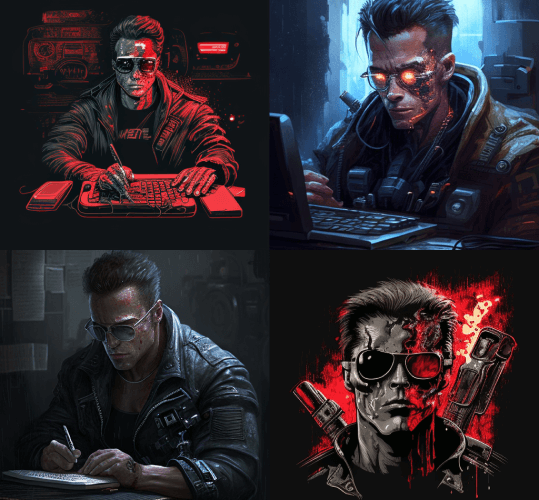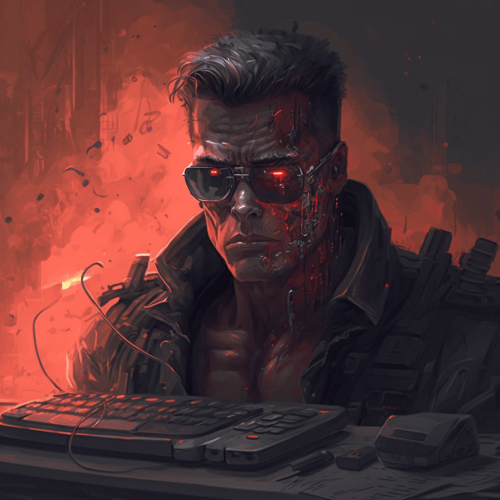
Artificial Intelligence (AI) & Creative Comms in 2023: Friend or Foe?

Rise of the machines
Don’t panic!
You haven’t travelled back in time to 2003 with Arnold Schwarzenegger reprising his role as “The Terminator” in the third and fading instalment of the robotic franchise. However, we did think “Rise of the Machines” was an apt title to introduce the rapid development and heightened global interest in Artificial Intelligence (AI) during the first part of 2023. Secondly, it’s also important for us to get any associated puns and comparisons out of the way early doors. But you know what, they might “be back!” as we progress…see, it’s too easy!
Coming back to reality (for a second), we’re going to be exploring the key areas in which AI technology is already assisting marketers and creatives around the world, outlining the benefits and pitfalls as we go.
81% of marketing and IT leaders surveyed by data platform Lytics said their two departments will become more integrated over the next five years, while 66% of marketers plan to integrate AI into their marketing stack in the short-term future.
Come with us if you want to learn more….!
AI in Marketing
Copy
One of the key tools marketing and ad agencies are using to test AI in the creative process is through AI copy generators, which can be used to create relevant content in minutes or even seconds. All users need to do is provide a question or prompts and the AI copy generator will respond by presenting information back to you in a humanistic, structured format. Tools such as Open AI’s Microsoft-backed ChatGPT (now on version 4) can respond in numerous formats including short stories, poems, essays, speeches, jokes, parodies, and even computer code. Marketers can also prompt the tool to respond to produce content in the form of blog posts, articles, ad headlines and copy.
ChatGPT vs. Bard
Google recently launched it’s ‘Bard’ AI tool, which can even undertake such tasks as planning events and drawing up lists of pros and cons to tackle difficult decisions. One of the key differences vs. ChatGPT is that Bard’s Language Model for Dialogue Applications (LaMDA) can draw responses from the internet, so it will always have the latest information. It’s also integrated into Google’s search engine and can provide direct links to websites when prompted. Alternatively, ChatGPT runs on Generative Pre-training Transformer-4 (GPT-4), so all of its responses derive from its knowledge base, which has a cutoff date ending in September 2021, so it’s limited in newer information and research. ChatGPT, however, is considered to be the most accessible and advanced AI copy generator at the time of writing — also available in nearly 100 languages, with Bard currently only available to Beta users in the UK & US.
Other key players to be aware of are Microsoft’s own branded Bing AI powered search engine, and Meta’s LLaMA. Both will offer similar services, but like Bard, are seemingly playing catch up with ChatGPT as it stands.
Proceed with caution
Naturally, big tech firms (and let’s face it, people all over the world) may be excited with this new technology (and it is fun to play with), but there are some concerns too on a professional level. Some fear that these tools, which are still developing, could threaten many different types of jobs including researchers, copywriters, and journalists. Another issue with AI writing tools is misinformation and bias. For example, Bard might bring up false information containing unnecessary stereotypes or discrimination because it gets its information from the internet, where biases exist. So, the key takeaway here is that you must proceed with caution and that we need human editing and fact-checking to take place at the very bare minimum.
Should content teams be concerned?
On the contrary! Although some might view AI as a threat to their job security, the reality is that AI has the potential to help creatives generate ideas and content more efficiently. For example, AI-powered writing assistants can help writers brainstorm ideas and structure their work, freeing up more time for them to focus on the creative aspects of their output. There’s still no substitute for the human touch when it comes to creating or editing content in terms of what’s fit for purpose. AI writing tools still can’t compete with humans on a stylistic point of view either. They lack the creative and artistic flair to match many human traits including tone of voice, emotion, and varying levels of complexity e.g. understanding how a retail promotion might work or to write in line with a brand’s identity and target audience.
Ben Williams, Global Chief Creative Experience Officer, TBWA agrees, “I believe the true power of these technologies and tools are not to replace creatives, but rather make us more efficient. There will always be a need for and value in creative direction, human curation, human refinement of an idea, and decision making in terms of what is right for the brand we’re working with.”
Don’t rely on AI to write all the copy for you. Its monotone and repeated descriptions of certain topics can make blog posts dull and sound automated, not to mention its similar responses to topics can cause a negative impact on SEO.
Visuals

Similarly, marketeers and advertisers are now also experimenting with AI tools that allow them to create visuals based on user prompts. Midjourney, Runway, Stable Diffusion, and Dall-E are all considered the most advanced tools in this space. Each of the tools generates images from natural language descriptions or prompts, taking your text description and running it through a Machine Learning (ML) algorithm. The final results are provided to you in the form of images that are best match imaginations or reimaginations based in line with what the tool has been ‘trained on’ i.e. a database of thousands of images.

As we kicked off this piece with the Terminator theme, we asked Midjourney to produce a series of images reimagining ‘The Terminator’ as a ‘Copywriter’ and as you can see the resulting images are extremely accurate in relation to the search terms. You can also ask the AI app to focus on one of the four results and uplift it, or simply request new versions so you can home in on exactly what you’re looking for.
Rights considerations
If a business is using AI tools to create original works, such as artwork or written content, there may be intellectual property issues to consider. The ownership of the AI-generated content may not be clear, and there may be questions around who has the right to use or distribute it. Marketing and advertising teams should seek legal advice to ensure they don’t end up with any tricky situations, particularly ahead of using AI generated imagery in their external campaigns.
Other roles for AI in Marketing
Judgement Day — which tools suit your business?
As well as content creation tools, marketers can also utilize the following AI tools.
Marketing automation
These platforms use AI algorithms to automate repetitive marketing tasks, such as email marketing, social media posting, and lead nurturing. Examples include HubSpot, Marketo, and Pardot.
Predictive analytics
These tools use machine learning algorithms to analyze customer data and predict future behavior, such as which customers are most likely to convert or churn. Examples include IBM Watson, SAS, and Google Analytics.
Chatbots
AI-powered chatbots can help to improve customer engagement by providing 24/7 support and assistance. Examples include Drift, Intercom, and Zendesk.
Personalization
These tools use AI to create personalized experiences for customers, such as personalized product recommendations or email content. Examples include Monetate, Dynamic Yield, and Evergage.
Image & video analysis
These tools use computer vision algorithms to analyze images and videos, such as identifying objects or people within the media. Examples include Amazon Rekognition, Google Cloud Vision, and Microsoft Azure Computer Vision.
Social media listening & sentiment analysis
These tools use natural language processing algorithms to analyze social media conversations and determine sentiment around a brand or topic. Examples include Brandwatch, Sprout Social, and Hootsuite Insights.
AI x data & advertising
When it comes to AI and data, businesses need to ensure that they are collecting and processing personal data in accordance with applicable data protection laws, such as GDPR or CCPA. This includes obtaining the necessary consents from individuals and implementing appropriate security measures to protect the data.
It’s also worth noting that AI data tools still aren’t at the level of understanding data as well as agencies who live and breathe it. Much like creative, ads need a human touch and level of management to be utilized properly. Think of AI as a tool business you can use to streamline certain aspects but should not be left alone to monitor data by itself.
AI doesn’t always lead to the best results. We have seen Performance Max make its way onto the scene, among other automated ad products like Meta Advantage, but there are still question marks over their effectiveness in boosting conversions. It’s important to remember that you’re giving ad platforms free rein to spend your budgets with very little visibility on where, how, and to whom your brand has appeared.
Hasta la vista, baby!
The bottom line when it comes to utilizing AI tools in marketing is to utilize the benefits, but don’t go auto-pilot. As with the Terminator series, if the machines are left in control, the results can be disastrous. Ok, humanity won’t be under threat from Skynet, but you could have some seriously embarrassing situations on your hands if you haven’t at least been partly at the controls. We need to take responsibility for overseeing the AI or automation process at hand, having the ultimate accountability.
Codeword, a tech marketing agency, “hired” two AI interns ― although a PR gimmick, this is how we should view AI tools to some degree. “This AI technology can produce the same level of quality work that an inexperienced employee might deliver”, say Richard Bowman and David Boyle — authors of the new book, Prompt: A practical guide to AI-powered brand growth with ChatGPT.
However, like the Terminator, and unlike an intern, AI doesn’t get bored, and it doesn’t stop. Ever. Until the mission is complete.